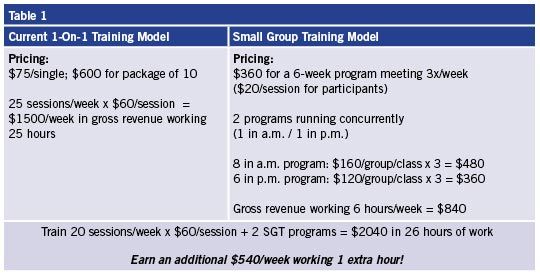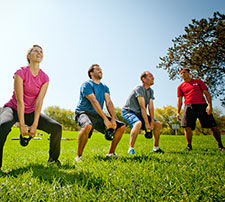
As health and fitness professionals, we usually fit into one of three groups: business owner, employee or independent contractor. All three have their own challenges and rewards and, depending on your situation in life, one option may be better suited for you than another. But whichever route you’ve chosen, you undoubtedly want to make the most of your time and reach as many people as possible to help them achieve their fitness goals. Research has shown that when people have the support of an instructor, coach or trainer and are in a group setting, they are more likely to stick with their programs (Spink and Carron, 1993). And isn’t this what we want—our clients reaching the goals they set out to achieve?
Small-group training has gradually found its way into the fitness industry over the past few years and, although we may think of this style of training like a traditional boot camp or group fitness class, there are many differences that set small-group training apart from these other training styles. If you’re thinking about adding a small-group class to your business model, or presenting an idea for a small-group program to your employer, here are a few things to consider:
- Small-group training is not the same as traditional group fitness. Group fitness classes traditionally involve one instructor and 15 or more participants, sometimes even up to larger groups of 50 to 100 people. The hallmark of small-group training is individual attention, which means each class should include no more than five to 10 people. While group fitness participants can drop in and out and classes are usually included in some kind of facility membership, small-group training classes typically require preregistration. There is often an additional fee (on top of membership dues) for participation in the program.

- Small-group training programs typically have a theme and are often focused on things like weight loss, learning how to use a piece of training equipment, or training for an event. When people sign up for such a program, they come in with the idea that they are among others who share a common goal, which helps create cohesion and rapport among participants. Likely, because participants share a common goal, they will share similarities in other aspects of their lives and may even gain a few more close friends to keep them accountable, during the length of the program and beyond.
- Small-group training programs last for a specific length of time. When designing your program, it’s important for both participant adherence as well as your financial peace of mind that you limit the program to a specific number of weeks. Four to 12 weeks is recommended, but it really depends on your theme. For example, 12 weeks of learning how to use a new piece of equipment might become monotonous. Conversely, a 4-week weight-loss program may not be long enough to allow for measurable changes to take place. It can also be both mentally and financially challenging for participants to commit to more than six to eight weeks at a time. To meet the needs of participants looking for short- and longer-term programs, consider offering a specific program for six to eight weeks, taking a one- to two-week break and then beginning a new program with a similar theme (or a completely different theme if your clientele responds favorably).
- Small-group training offers a financial benefit to both clients and trainers. Arguably, the biggest benefit of running small group-training programs is that it allows clients to pay a lower cost for individualized attention, while also giving them the opportunity to develop camaraderie with and receive motivational support from, other group members. For the trainer, even though you may charge less per client, you are able to train multiple clients at once, which significantly increases your hourly income. It is important, however, to figure out all your costs prior to offering your small group-training program so that you can select a price point that will work for your clients and still benefit your business. For example, let’s say you normally charge $75 for a personal-training session, but offer a package of 10 sessions for $600. If you do 25 sessions per week at $60 each, your gross weekly income would be $1,500 (not including expenses such as insurance, equipment, space rental, employer percentage, etc.).
Now let’s see what would happen if you performed 20 one-on-one sessions, but also offered two small-group training programs at $360 for a six-week program meeting three times per week (18 total sessions = clients pay $20 per session). Let’s pretend that you have six people join one session and eight people in the other. Each pays $360 for the program, which means you receive $5,040 up front. Dividing this income from the two programs over the six weeks, you would earn $840 each week. Combined with the 20 hours of one-on-one sessions at $60 each, you’ll be taking in a grand total of $2,040 per week, which amounts to an extra $540 per week for only one additional hour of work. Take a look at Table 1, which is from the ACE Small Group Training workshop manual, for the complete math breakdown.

In this example, not only do you get the benefit of receiving more than $5,000 up front, which offers you some additional financial stability, your group-training clients also are receiving the benefits of personalized training at a discounted rate.

- Small-group training programs can help spread the message of fitness to a wider audience. When you are working one-on-one with clients, you are able to have an amazing affect on one person’s life—an amazing thing in and of itself. But wouldn’t it be great if you could share your knowledge of health and fitness with more people at one time? Small-group training programs are a platform that can include group Facebook pages, team T-shirts, educational sessions, and group forums that promote discussion and sharing of health and fitness information that may be harder to do while working with only one personal-training client at a time.
- Small-group training programs usually attract clients who are already ready for change. When a person goes as far as paying for a program that will last for a number of weeks, they are making a commitment to fitness for at least the duration of the program. When a client sets off on a new fitness journey, especially when weight-loss is involved, he or she is likely facing numerous barriers—things like lack of motivation, education or accountability—that will need to be overcome. When training in a small-group setting, other members of the team can provide a huge amount of motivation, either through friendly competition or by simply sharing in the experience of adopting a healthier lifestyle. Group members may find additional ways to connect, such as discussion forum, Facebook page or group text, can be helpful for sharing their challenges, triumphs and questions. By allowing clients to share their experiences with one another and use others in the group as a sounding board, change can take place. Group members may also be helpful in holding others accountable for their actions, both in and out of the training sessions. The bonds that often form between group members can be a huge boost to the healthy lifestyle habits you are trying to promote and instill in your clients.
Are you convinced? There’s never been a better time to start working on developing your own small-group training program. Come up with a theme, pricing structure and schedule, and present it to your employer. Don’t forget to do some research in your area to see what others are offering to help make sure your small-group training programs stand out from the crowd. The goal is to find ways to help our clients achieve their goals, while also ensuring you can earn the income you need to continue doing this work that is so essential to the health of others, and small-group training programs are a great way to do both.
Want to Learn More About How You Can Launch Your Own Small Group Training Program?
Filling your schedule can be challenging, especially when most of your clients are restricted to early-morning, lunch or late-evening sessions due to work. That’s why it’s so important to learn how to maximize your time and earning potential by training multiple clients simultaneously with small-group training.
This one-day workshop reveals specific strategies and techniques for designing and marketing small-group training programs based on the innovative ACE Integrated Fitness Training® (ACE IFT®) Model. You’ll also learn why having multiple clients in one session can enhance long-term commitment by fostering accountability among clients.
There are no prerequisite educational requirements and you can earn 0.8 CECs for this one-day live workshop. To learn when this live workshop will be offered in your area, check out ACE’s website. For registration questions, please call ACE's Program Coordinator at 800-825-3636, Ext. 713.
Reference
Spink, K.S. and Carron, A.V. (1993). The effects of team building on the adherence patterns of female exercise participants. Journal of Sport & Exercise Psychology, 15, 39-49.





 by
by 





